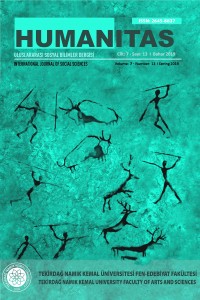Araştırma Makalesi
Yıl 2019,
Cilt: 7 Sayı: 13, 148 - 158, 22.03.2019
Öz
Son yıllarda çeşitli bilimsel ve teknolojik gelişmelerin meydana gelmesiyle insan her şeyin ölçüsüdür fikrini savunan hümanist bakış açısına karşı trans-/posthümanist akımlar meydan okumaya başlamıştır. Üstelik insan olmanın anlamı, Cary Wolfe, N. Katherine Hayles, Donna Haraway gibi kuramcılar tarafından sorgulanmıştır. Bu noktada ben/öteki, insan/insan olmayan, beden/akıl kavramları trans-/posthümanizm çerçevesinde yeniden şekillenmiştir. Distopya türünün örneklerinden Margaret Atwood’un Antilop ve Flurya (2003) romanı sadece insan sonrası durumu gözler önüne sermekle kalmaz, aynı zamanda karakterlerin kimlik sorununu da gösterir. Bu çalışma özgünlük, ötekileştirme, kimlik arayışı kavramlarını post-/transhümanist kuramlar ve dönemin öne çıkan meseleleri bağlamında değerlendirerek ana karakterlerin kırılma noktalarını inceler. Aynı zamanda insan merkezciliğin radikal bir zemin bularak insan sonrası çağın da etkisiyle yaratabileceği felaket senaryolarında insan olmayan hayvanlarla ilişkinin nasıl şekillendiği, insanın kimlik oluşumuna nasıl katkıda bulunduğu da irdelenmiştir.
Anahtar Kelimeler
Margaret Atwood posthümanizm hayvan hakları ötekileştirme özne
Kaynakça
- Atwood, M. (2004). The handmaid’s tale and oryx and crake in context. PMLA, 119(3), 513- 517.
- Atwood, M. (2013). Oryx and crake. London: Virago Press.
- Crutzen, P. (2002). Geology of mankind. Nature, 415(3), 23.
- Freud. S. (1985). The uncanny. (J. Strachey, Trans). (Ed. Albert Dickson), Art and Literature, Penguin Freud Library, 14. Harmondsworth: Penguin, (Original work published 1919).
- Golban, T., Benli, D. (2017). The quest for an authentic self: memory and identity in Philip Ridley’s mercury fur. Border Crossing, 7(2), 305-316.
- Parry, J. (2009). Oryx and Crake and the new nostalgia for meat. Society and Animals, 17, 241-256.
- Rimmer, M. (2008). Intellectual property and biotechnology: biological inventions. Cornwall: Edwar Elgar Publishing.
- Ryder, R. D. (2010). Speciesism again: the original leaflet. Critical Society, 2
- Sanderson, J. (2013). Pigoons, rakunks and crakers: margaret atwood’s oryx and crake and genetically engineered animals in a (latourian) hybrid world. Law and Humanities, 7(2), 218-240.
Yıl 2019,
Cilt: 7 Sayı: 13, 148 - 158, 22.03.2019
Öz
Recently, numerous scientific and technological advances have taken place and the idea of man as the measure of all things has been challenged by the flourishing manifestations of trans-/posthumanism. Therefore, what it means to be human has been questioned by various theoreticians like Cary Wolfe, N. Katherine Hayles, and Donna Haraway. In this regard, concepts like Self/Other, human/non-human, body/mind are analysed in the framework of trans- and posthumanism. Margaret Atwood’s Oryx and Crake (2003) not only indicates a posthuman condition but also illustrates the question of identity regarding the characters. Consequently, this study discloses breaking points which involve issues of authenticity, othering, as well as identity explorations of the individuals based on post-/transhumanist theories and significant issues of the contemporary age. In addition, the study scrutinizes the human-nonhuman animal relationship and how it contributes to the identity formation of the human in a posthuman era.
Anahtar Kelimeler
Kaynakça
- Atwood, M. (2004). The handmaid’s tale and oryx and crake in context. PMLA, 119(3), 513- 517.
- Atwood, M. (2013). Oryx and crake. London: Virago Press.
- Crutzen, P. (2002). Geology of mankind. Nature, 415(3), 23.
- Freud. S. (1985). The uncanny. (J. Strachey, Trans). (Ed. Albert Dickson), Art and Literature, Penguin Freud Library, 14. Harmondsworth: Penguin, (Original work published 1919).
- Golban, T., Benli, D. (2017). The quest for an authentic self: memory and identity in Philip Ridley’s mercury fur. Border Crossing, 7(2), 305-316.
- Parry, J. (2009). Oryx and Crake and the new nostalgia for meat. Society and Animals, 17, 241-256.
- Rimmer, M. (2008). Intellectual property and biotechnology: biological inventions. Cornwall: Edwar Elgar Publishing.
- Ryder, R. D. (2010). Speciesism again: the original leaflet. Critical Society, 2
- Sanderson, J. (2013). Pigoons, rakunks and crakers: margaret atwood’s oryx and crake and genetically engineered animals in a (latourian) hybrid world. Law and Humanities, 7(2), 218-240.
Toplam 9 adet kaynakça vardır.
Ayrıntılar
| Birincil Dil | İngilizce |
|---|---|
| Bölüm | Tüm Sayı |
| Yazarlar | |
| Yayımlanma Tarihi | 22 Mart 2019 |
| Yayımlandığı Sayı | Yıl 2019 Cilt: 7 Sayı: 13 |
Cited By
Ecocatastrophe in Margaret Atwood’s Oryx and Crake
SÖYLEM Filoloji Dergisi
https://doi.org/10.29110/soylemdergi.1051596









